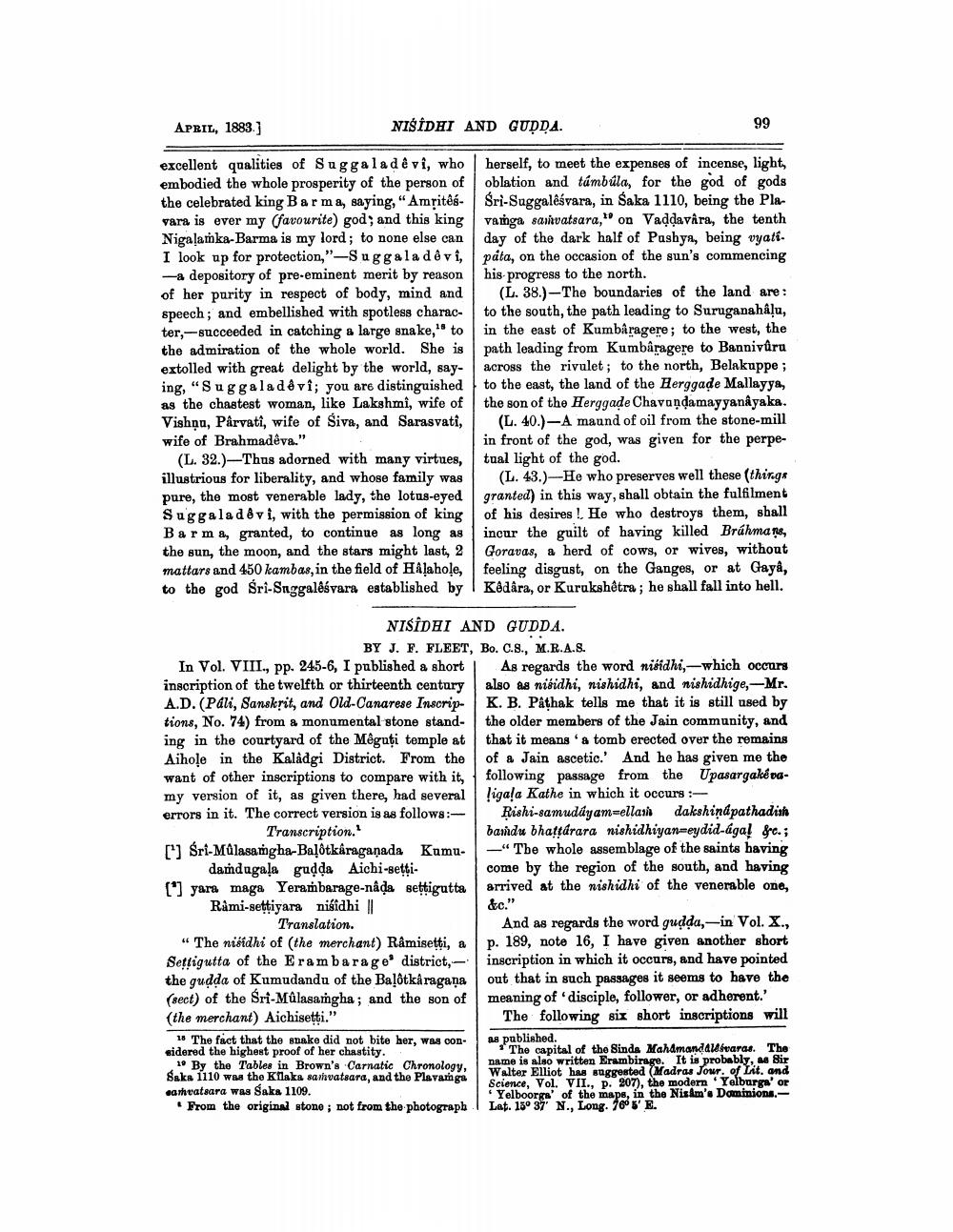________________
NISIDHI AND GUDDA.
APRIL, 1883.]
excellent qualities of Suggaladê vi, who embodied the whole prosperity of the person of the celebrated king Bar ma, saying, "Amritêsvara is ever my (favourite) god; and this king Nigalamka-Barma is my lord; to none else can I look up for protection,"-Suggaladevi, -a depository of pre-eminent merit by reason of her purity in respect of body, mind and speech; and embellished with spotless character, succeeded in catching a large snake," to the admiration of the whole world. She is extolled with great delight by the world, saying, "Suggaladêvî; you are distinguished as the chastest woman, like Lakshmi, wife of Vishnu, Pârvati, wife of Siva, and Sarasvati, wife of Brahmadêva."
(L. 32.)-Thus adorned with many virtues, illustrious for liberality, and whose family was pure, the most venerable lady, the lotus-eyed Suggaladevi, with the permission of king Barma, granted, to continue as long as the sun, the moon, and the stars might last, 2 mattars and 450 kambas, in the field of Halahole, to the god Śri-Snggalêsvara established by
In Vol. VIII., pp. 245-6, I published a short inscription of the twelfth or thirteenth century A.D. (Páli, Sanskrit, and Old-Canarese Inscriptions, No. 74) from a monumental stone standing in the courtyard of the Mêguți temple at Aihole in the Kaladgi District. From the want of other inscriptions to compare with it, my version of it, as given there, had several errors in it. The correct version is as follows:Transcription.
NISIDHI AND GUDDA.
BY J. F. FLEET, Bo. C.S., M.R.A.S.
[] Sel-Múlasangha-Balitkáraganada Kamudamdugala guḍḍa Aichi-setti[] yara maga Yerambarage-nåda settigutta Rami-settiyara nisidhi ||
Translation.
"The nisidhi of (the merchant) Râmisetti, a Settigutta of the Erambarage district, the gudda of Kumudandu of the Balôtkåragana (sect) of the Sri-Mûlasamgha; and the son of (the merchant) Aichisetti."
18 The fact that the snake did not bite her, was considered the highest proof of her chastity.
19 By the Tables in Brown's Carnatic Chronology, Saka 1110 was the Kilaka samvatsara, and the Plavamga eamvatsara was Saka 1109.
From the original stone; not from the photograph
99
19
herself, to meet the expenses of incense, light, oblation and túmbúla, for the god of gods Śri-Suggalêsvara, in Saka 1110, being the Plavaiga samvatsara, on Vadḍavara, the tenth day of the dark half of Pushya, being vyati. pata, on the occasion of the sun's commencing his progress to the north.
(L. 38.)-The boundaries of the land are: to the south, the path leading to Suruganahâļu, in the east of Kumbâragere; to the west, the path leading from Kumbâragere to Bannivûru across the rivulet; to the north, Belakuppe ; to the east, the land of the Herggade Mallayya, the son of the Herggade Chavandamayyanayaka.
(L. 40.)-A maund of oil from the stone-mill in front of the god, was given for the perpetual light of the god.
(L. 43.)-He who preserves well these (things granted) in this way, shall obtain the fulfilment of his desires. He who destroys them, shall incur the guilt of having killed Brahmans, Goravas, a herd of cows, or wives, without feeling disgust, on the Ganges, or at Gayâ, Kêdâra, or Kurukshetra; he shall fall into hell.
As regards the word nisidhi,-which occurs also as nisidhi, nishidhi, and nishidhige,-Mr. K. B. Pathak tells me that it is still used by the older members of the Jain community, and that it means a tomb erected over the remains of a Jain ascetic.' And he has given me the following passage from the Upasargaké valigala Kathe in which it occurs :
Rishi-samudayam-ellash dakshinapathadish bandu bhattárara nishidhiyan-eydid-ágal &c.; "The whole assemblage of the saints having come by the region of the south, and having arrived at the nishidhi of the venerable one, &c."
And as regards the word gudda,-in Vol. X., p. 189, note 16, I have given another short inscription in which it occurs, and have pointed out that in such passages it seems to have the meaning of 'disciple, follower, or adherent.'
The following six short inscriptions will as published.
The capital of the Sinda Mahamandalesvaras. The name is also written Erambirage. It is probably, as Sir Walter Elliot has suggested (Madras Jour. of Lit. and Science, Vol. VII., p. 207), the modern Yelburga' or Yelboorga' of the maps, in the Nizam's Dominions.Lat. 15° 37 N., Long. 76° 5' E.




